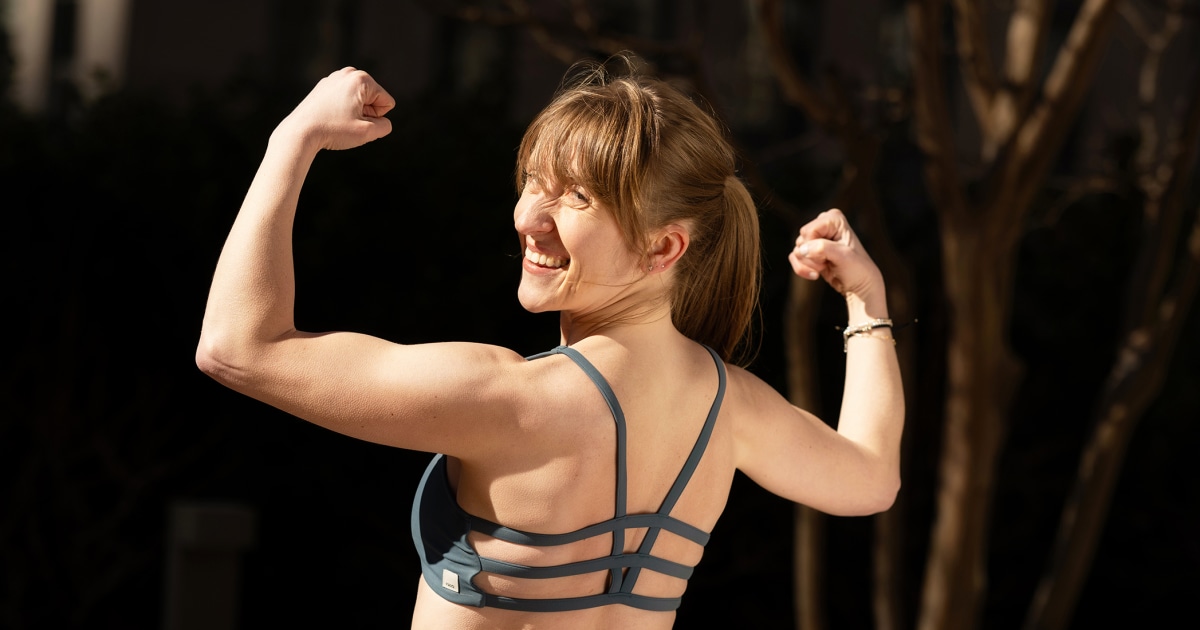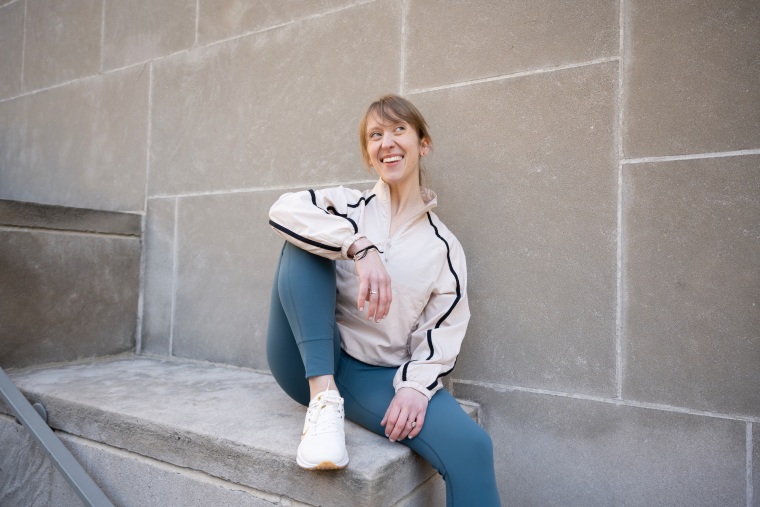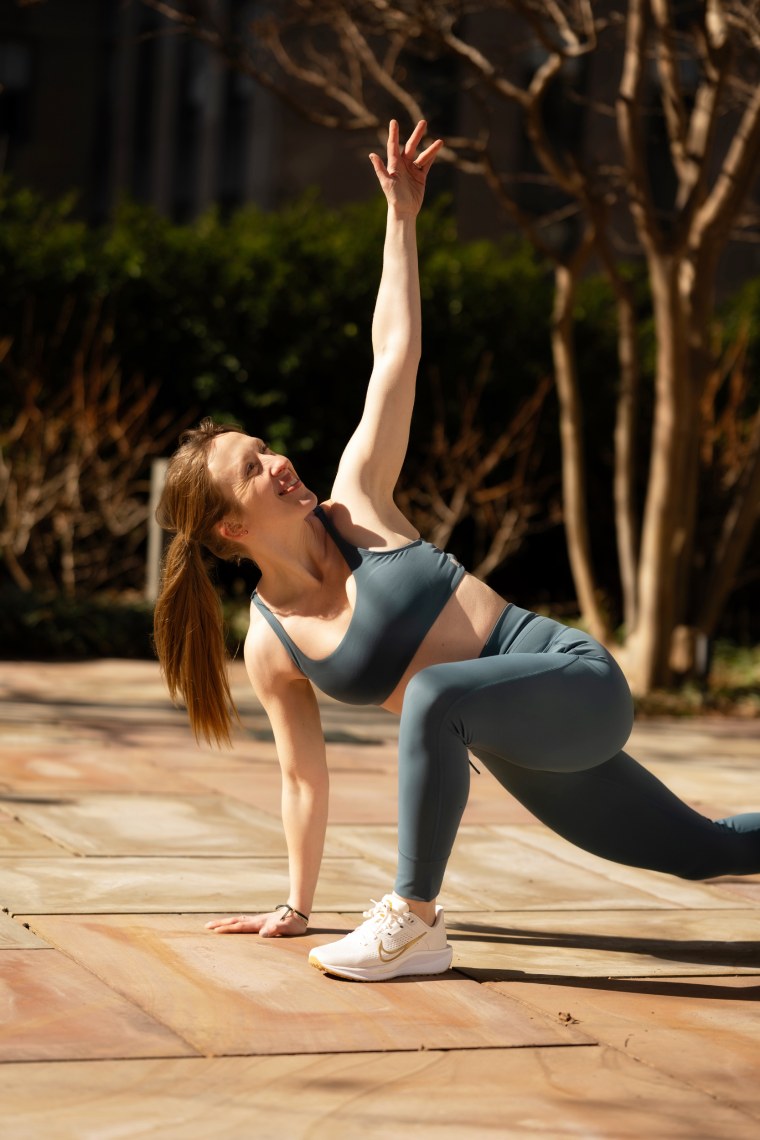Fitness
New mums are being ‘strongly encouraged’ to take regular exercise and get more sleep. Don’t make me laugh | Rhiannon Lucy Cosslett

One of the many things you don’t realise until you have a newborn is just how much people congratulate you simply for leaving the house. “Well done for getting out and about,” they say, with the cheerful camaraderie of People Who Know. Going outside may sound like a low benchmark, but during those early weeks summoning the energy to put on clothes, pack a bag, and then using that narrow window between sleeping, feeding, pooing and screaming to cross the threshold into the world can feel like the grand sum total of all human endeavour. Screw the frescoes of the Scrovegni chapel: Mama made it to Budgens.
Which explains my reaction when I read that new guidelines published in the British Journal of Sports Medicine say that new mothers should be strongly encouraged to do at least two hours of moderate to vigorous exercise a week, in addition to “daily pelvic floor muscle training”, and further that they should develop a “healthy sleep hygiene routine”, avoid screen time and “maintain a dark, cool, quiet environment before bed”.
Hahahahahahahahahahahahahahahahahahahaha.
Where to start with this? Maybe with the phrase “strongly encouraged”, as though new mothers don’t get enough of that. In the absence of proper, structural support, strong encouragement is all society has. Take an anonymous call I received a few days after we were discharged from the hospital, still reeling from a complicated birth (when people ask what kind it was, I say: “I think maybe … all of them?”) I picked up the phone. “Hello?” I said, tentatively. I was in the bathroom at the time, observing the carnage of my life and body with the sort of stoned detachment that comes with zero sleep and opioid withdrawal. “HELLO. ARE YOU EXERCISING YOUR PELVIC FLOOR?” a woman bellowed down the line. “Who is this?” I said. “I AM CALLING FROM THE WHITTINGTON HOSPITAL. YOU NEED TO MAKE SURE YOU ARE DOING YOUR KEGELS. OK, BYE.”
In France, pelvic floor rehabilitation is a cornerstone of postnatal care, with the government providing physio sessions. Here, a midwife with a list of numbers and a robust phone manner yells at you about your ruined vagina. I still think fondly of her. But I think if she had also told me to do two hours of exercise and develop a healthy sleep routine as well, I’d have “strongly encouraged” her to do something else with her phone.
Look, I am not saying the advice isn’t important. As the professionals who have written this paper say, the postpartum period puts women at risk of all kinds of health problems, and is “a unique and critical window of opportunity to identify people at high risk for future chronic disease and to implement early interventions to improve lifelong health”. Of course it’s beneficial to become mobile as soon as possible after the birth, and to get as much sleep as you are physically able. New mothers know this. But they also know that achieving basic tasks, often in the absence of much support, can feel nigh-on impossible. Had I tried to develop their description of a healthy bedtime routine, I’d have basically been consigned to a dark room while my son did cluster feeding (and cluster pooing) for five hours. Is it any wonder I opted for binge-eating flapjacks in front of back-to-back Stanley Tucci: Searching for Italy?
When postpartum, in order to carve out time for exercise and sleep, you need a support system around you. You need visits from health professionals, an engaged partner who doesn’t go back to work after a mere two weeks, and your family around you (the paper acknowledges this, too). I was lucky enough to have this, and I still found it hard to find a moment for myself, so I can only imagine how hard it must be if you’re less supported. I expect these guidelines will just become another thing that many new mothers feel they are failing at, and the NCT agrees, saying that parents may find the pressure “overwhelming”.
I’ve just been reading Becky Barnicoat’s brilliant and hilarious Cry When the Baby Cries, a graphic memoir which vividly evokes those feverish, feral, fluid-soaked months after giving birth (she is an advocate, by the way, of achieving absolutely nothing as a survival tactic). There’s a part in the book where she goes for her postpartum doctor visit, six weeks after an emergency C-section, and he shames her for not doing exercise: “Most women like to get their bodies back as quickly as possible.” The following image, of her pushing the pram home with tears streaming down her face, viscerally captures the impact that a few unkind words can have on you at this time of deep vulnerability.
Too many of us have had moments like these, when someone could have been kind, but wasn’t. When it comes to guidelines for new mums, far less thought seems to be put into the manner of delivery. Sometimes “advice” is delivered so cruelly that it stays with you for years afterwards. There are many things I wish for postpartum women: better healthcare, better support (like in the Netherlands), better paternity leave, often, sadly, better husbands. But most of all, I wish people were a bit nicer to them.
What’s working
My son has been enjoying the new trampoline his dad gave him for his third birthday, especially to a soundtrack of disco music. It confirms my belief that, when parenting feels tricky, a “vibe shift” can work wonders. I was feeling emotional and exhausted yesterday, but watching him bounce, grinning, to Le Freak, somehow made everything feel OK again.
What’s not
Several good friends are dealing with toddlers who run off, sometimes towards traffic. Reins are largely frowned upon by this generation of parents (one friend even received judgmental comments for using them in the vicinity of actual lions while at a safari park), but it got me thinking how they did perform quite an important safety function. Is it time to rehabilitate them, or at least be a bit more understanding of one another?

Fitness
Is This Muscle-Building Protocol All Hype? Here’s What You Need to Know.

IF YOUR MEDIA diet puts you into certain corners of the muscle-obsessed fitness internet, you know about lengthened partials. If you don’t immediately recognize the term, we’ll get you up to speed: Lengthened partials are fractional reps performed with the target muscle in its stretched position. Good examples of this include the lower half of a pullup or biceps curl. Rather than raising the weight (or your body, in the case of the pullup) up through the exercise’s full range of motion, you’ll only go to about halfway to the top. Why? Muscle researchers have found that in many cases, those half-reps can still yield growth.
Anyone plugged-in enough to be familiar with the concept has also likely heard all kinds of wild theories about the protocol: Lengthened partials should be used for any and all exercises, no one should ever do a full rep ever again, your gains will jump by exponential degrees by using this one magic trick—the list goes on. There’s a lot of noise out there about this approach, and MH experts are trying to cut through it in our recent Strong Talk discussion.
“The problems with [the conversation around lengthened partials] right now is everyone’s trying to research every muscle,” said exercise physiologist and strength and conditioning coach Dr. Pat Davidson. Davidson was dismissive of some of the studies surrounding the protocol, as researchers seem to be approaching the topic both broadly in, terms of the muscle groups being tested, and with a limited scope of focus for the experiments. “They don’t give enough time and the stimulus is just kind of weird in some of these things. It’s going completely overboard.”
Fitness
As a woman, I used to be afraid of lifting weights. Now, I’m proud to be ‘jacked’

A childhood with an emphasis on skinnyI have no recollection of the term “strength training” growing up. I entered high school in 2006 and threw myself into cross-country running, where slender was the ideal body type. The petite stars of “The Hills” and “Gossip Girl” covered CosmoGirl and Seventeen next to “get bikini-ready” headlines, and judges on “America’s Next Top Model” scrutinized women’s bodies on national TV.
Instead of weight-lifting, I was focused on squeezing into a pair of low-rise jeans from Delia’s.
The only time I recall lifting a weight as a teen was on a gym date with a guy from school. He showed me how to do a barbell bench press and dripped sweat on me while spotting me.
If this was a woman’s experience trying to lift weights, I wanted nothing to do with it. Plus, with no resources or role models showcasing the benefits of getting strong, I assumed that it only led to a muscular upper body, the total opposite of what I was seeing in my magazines.
The truth is strength training can improve bone, heart and brain health, boost your metabolism, preserve quality of life as you age, reduce the risk of disease and more. But even if I knew all this when I was younger, I still probably would’ve avoided it, given the mental images strength training conjured.
One of the first-known female pioneers in weightlifting was Abbye “Pudgy” Stockton, credited for popularizing Santa Monica’s Muscle Beach with her husband in the 1930s and ‘40s, per the Los Angeles Times. But it wasn’t until the ‘80s that women and weightlifting become more mainstream, after Arnold Schwarzenegger put bodybuilding on the map when he appeared in the 1977 documentary “Pumping Iron,” per the New York Times.
From there, Lisa Lyons, Carla Dunlap, Rachel McLish and more bodybuilders emerged in the ’80s, and before long, gyms were turning co-ed.
Fast-forward to the 2000s, and at-home DVD workouts that focused on building strength became bestsellers, like Tony Horton’s P90X and Jillian Michael’s “Shred” workouts. CrossFit also rose to stardom and introduced women and men alike to strength training (with some injuries along the way).
By 2010, when I started college, I still didn’t see myself in strength training. Doing a workout DVD in my dorm room wasn’t practical, and CrossFit felt beyond my skillset. After I gained the freshman 15, I became hawk-eyed on weight loss. My senior year, I picked up running again, and after graduation, I ran my first half marathon.
After the race, when I combed through professional photos, one caught my attention. I thought my arms looked strong. I purchased it and made it my profile picture on Facebook. Years later, friends and family told me that photo concerned them because of how thin I was.

In 2017, I started working as a social media editor at a health and fitness magazine, and I wrote a before-and-after about my 40-pound weight loss dating back to college. After it published, I did what all the editors warned me not to: look at the comments. It was a mixed bag, but one that bluntly stated I looked better in the before image burned into my mind.
I got into the New York City Marathon that same year, so I added more miles to my runs. I ignored advice that I should cross-train and stuck to hitting the pavement, with the occasional spin or Barry’s class. I was all in on legs, and that seemed to work for me up until that point — why would I do otherwise?
I kept running, with the perception that beauty and skinny went hand in hand.
A gateway into strength training
When the pandemic hit in March 2020, my now-husband, Sam, and I retreated to his parents’ for a few months. At first, running was my sanctuary, but it became lonely. I turned to social media and joined live workouts led by fitness instructors and studio owners.
In no time, I was doing one or two a day in the basement that became my makeshift gym. I started sharing workout reviews on my Instagram to help others looking for a sense of semi-normalcy.

Some classes encouraged using weights, and my future father-in-law had a set of adjustable iron-plated dumbbells. “I’ll just use the 5-pounder,” I thought to myself. I never increased the load, but choosing to reach for anything was new for me.
Around the same time, thought of teaching fitness crept into my mind. While we were hunkering down, I yearned to progress forward, so I enrolled in an online course to become a certified group fitness instructor in July 2020. I shared the news on Instagram with a flex.
Fitness
Do you know that for every hour you exercise, you can add up to 3 hours to your life? – The Times of India

Enough has been said about the benefits of exercise. 30 minutes of exercising everyday is known to have long-term health effects, including lowering your BP, better cardiovascular health, and even weight loss. However, do you know that for every hour you exercise, you can actually increase your lifespan by three hours? Yes, you heard that right!
Exercise, and live longer
Dr. John Scharffenberg, a professor of nutrition at Loma Linda University in California, shared some tips for living a longer life in a YouTube video. At the remarkable age of 100, the centenarian shared that one of the biggest tools to live longer is exercise, and for every hour you exercise, you add three hours to your life. He also mentioned that while exercise is important at every age, you must definitely exercise between the ages of 40-70, as your body start to degenerate at 40.

Here are some more tips that he added:
Tobacco: The doctor outlines the dangers of tobacco, known since the 1964 Surgeon General report. He said that when it comes to Alzheimer’s, it has an extremely small percentage of tobacco users. That is because tobacco users do not live long enough to get any chronic disease later on.
Alcohol: Following closely on the heels of tobacco is alcohol. Dr. Scharffenberg said that especially for women, alcohol increases the chances of getting breast cancer. He also added that while earlier studies claim that two drinks a day for men, and one drink a day for women was probably safe, new studies refute that, and add no amount of alcohol is safe.
Exercise: As mentioned earlier, Dr. Scharffenberg is a huge advocate of exercise, and recommends it everyday. He adds that even if someone is obese and exercises everyday, he will still outlive a person who is thin, but does not exercise. And, while a lot of people think that 40 is the age to slow down, on the contrary, one should start exercising the most from this age, upto the age of 70.
Smoking: At one point of life, smoking will kill you, says Dr. John Scharffenberg. It could be at 40 or 60, depending on how long you have been smoking. And unlike alcohol, on which debate is sketchy, there is no debate on smoking – even 1 cigarette is not recommended.

Diet: Dr. Scharffenberg largely recommends a vegetarian diet, with an occasional lean meat here and there. According to him, “The optimum diet is the vegetarian diet. Everybody should know this. It’s not something unusual.” He notes that top scientists advised the U.S. government in 2015 that a vegetarian diet is among the optimal dietary patterns, as it can help reduce the risk of age-related diseases.
This apart, Dr. Scharffenberg recommends low consumption of sugar, reducing fat intake, and other lifestyle changes that can make you live longer.
-

 Movie Reviews1 week ago
Movie Reviews1 week agoFilm Review: Rachel Zegler is the Best Part of an Otherwise Dull Remake of ‘Snow White’ – Awards Radar
-

 News1 week ago
News1 week agoShooting at Park in New Mexico Leaves at At Least 3 Dead and 16 Injured
-

 Education1 week ago
Education1 week agoICE Tells a Cornell Student Activist to Turn Himself In
-

 News6 days ago
News6 days agoTrump Is Trying to Gain More Power Over Elections. Is His Effort Legal?
-

 Politics1 week ago
Politics1 week agoEXCLUSIVE: Groundbreaking new prayer book designed for demographic most targeted for abortion
-

 News1 week ago
News1 week agoWashington Bends to RFK Jr.’s ‘MAHA’ Agenda on Measles, Baby Formula and French Fries
-

 News1 week ago
News1 week agoLeft-Wing Democrats Wait on AOC’s Decision as They Look to 2028 Election
-

 News6 days ago
News6 days agoCompanies Pull Back From Pride Events as Trump Targets D.E.I.














